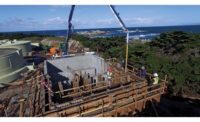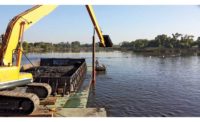Penitencia Seismic Retrofit
San Jose, Calif.
Best Project
Owner: Santa Clara Valley Water District
Lead Design/Civil/Structural/MEP Firm: Carollo Engineers Inc.
General Contractor: Ranger Pipelines Inc.
Seismic Design: Ballantyne Consulting LLC
Pipeline: Degenkolb Engineers
Geotechnical Engineer: Cal Engineering & Geology Inc.
Landscape Architecture: NUVIS
In delivering seismic retrofits to the Penitencia delivery main and force main near San Jose, the design team faced two major issues. The project, which aims to improve reliability of three critical water supply/delivery pipelines, crosses from a stable geologic zone to a landslide area at Penitencia Creek near the Penitencia Water Treatment Plant. The area is particularly vulnerable to failure in the landslide area during an earthquake.
The existing pipelines consisted of the 66-in. Penitencia delivery main, the 60-in. Penitencia force main, both owned by the Santa Clara Valley Water District, and the 72-in. South Bay Aqueduct, owned by the California Dept. of Water Resources.
The pipelines supply raw water to the PWTP and deliver treated water to the district’s customers. The pipelines were designed to accommodate an estimated 7.7 ft of seismic displacement and 1.7 ft of creep, for a total displacement of 9.4 ft over the 50-year design life. Most importantly, the project needed to protect the safety of nearby residents and a nearby elementary school.
“A landslide was creeping every year, and one time a pipe broke and flooded the whole area,” says Emmanuel Aryee, capital engineering manager at Santa Clara Valley Water District. “The earthquake fault is located less than 10 miles away from the pipe location. The challenge was that we couldn’t find any pipe system in the U.S. that could help solve the two challenges. You could find a pipe that solved one, but not the other.”
The team designed a solution that used the first large-diameter earthquake resistant ductile iron pipe (ERDIP) installation in the U.S. ERDIP has a nearly 50-year track record in Japan for critical infrastructure.
The manufacturer conducted full-scale laboratory tests of sample 60-in. and 72-in. collar joints, which met or exceeded the specified moment and deflection angle capacities.
The project also faced several constructibility challenges including meeting a tight construction schedule, working within a 50-ft easement with houses on both sides, sequencing work within a protected-bird buffer zone and installing the pipelines during periods of record rainfall.
Back to "ENR California Best Projects 2018: Region's Best Work Shines With Creativity"




Post a comment to this article
Report Abusive Comment